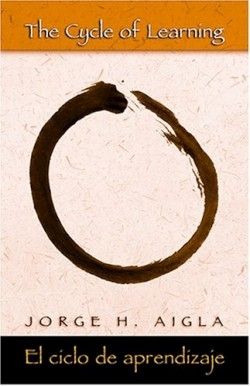The Cycle of Learning/El ciclo de aprendizaje
In a world of ever-increasing specialization and narrow approach to life, this author seems a messenger from hungrier times. His professional credentials run the spectrum from karate-dō instructor, medical examiner, and college professor, as well as writer. This voracious capacity for—and interest in—life is the heartbeat of this collection.
Sometimes poetry can come across as coy cipher, keeping the reader at a distance with acrobatic language and obscure imagery. This collection is plainly spoken, full of a desire to bear witness. True to its title, it largely follows the maturation of the narrator, tracing the cycles of his life and the teaching moments that have informed it. In the opening poem, he writes, “I stared at the enormity / of some of my actions / and of my secret inertias. / I opened once more / the cycle of learning.” This desire toward openness is key in the collection.
The tone of the poems is very personal, tender, and grateful. Some of the most moving passages deal with the poet’s son. In “Andrés Shō Dan,” written to commemorate his son’s black belt, Aigla writes, “While you do kata / a flower opens in my heart, / and listening to you kiai / makes my eardrums the anvil of the dōjō.” Though universal themes, such as the parent—child bond, underlie the work, there are no overtures to imply the reader in the moment. It is in every way an homage to all that has formed and enriched Aigla’s being. The reader is invited to reach into the poem and forge the connection there.
This is Aigla’s third collection of poetry, and his first to be totally bilingual, written in English and Spanish. The version in which each poem was originally written comes first, with its translation facing. The collection then becomes an exploration into language and translation, how the subject is transformed by lexicon, and how the bilingual mind works. Since Aigla is both author and translator, any variation illuminates rather than dilutes the original. As language is limited, the most exciting possibilities lie for the bilingual reader who can benefit from the third poem, which rises from the interlingual mingling of image and phrase.
In a very few poems the emotion overcomes the writer’s discipline and the language slips into ill-used rhyme and smarmy image. In the face of the rigor of feeling and form of the rest of the collection, the reader can perhaps forgive these moments as learning places for the writer as he continues to move forward in his poet’s education.
Reviewed by
Naomi Millán
Disclosure: This article is not an endorsement, but a review. The publisher of this book provided free copies of the book to have their book reviewed by a professional reviewer. No fee was paid by the publisher for this review. Foreword Reviews only recommends books that we love. Foreword Magazine, Inc. is disclosing this in accordance with the Federal Trade Commission’s 16 CFR, Part 255.

